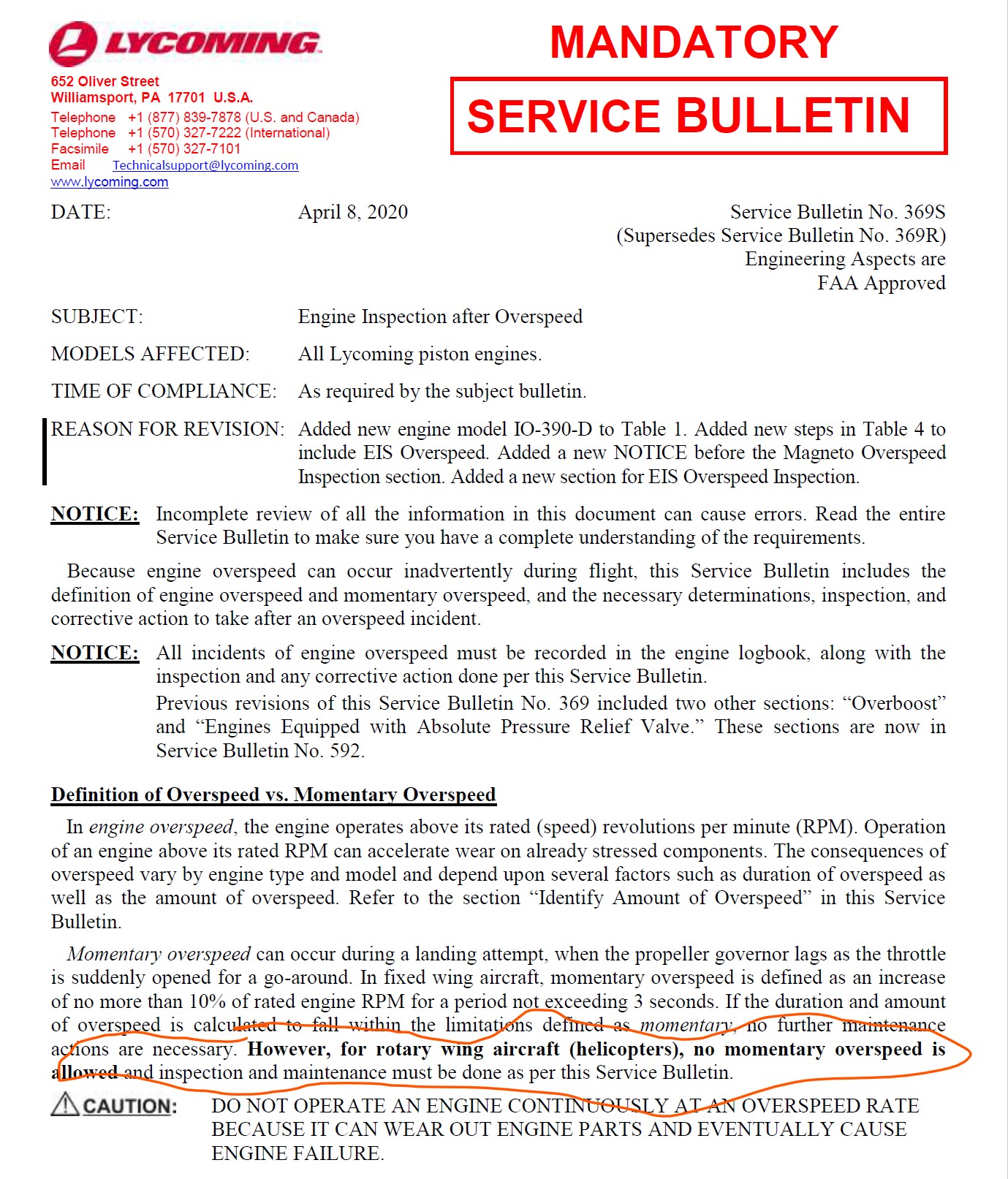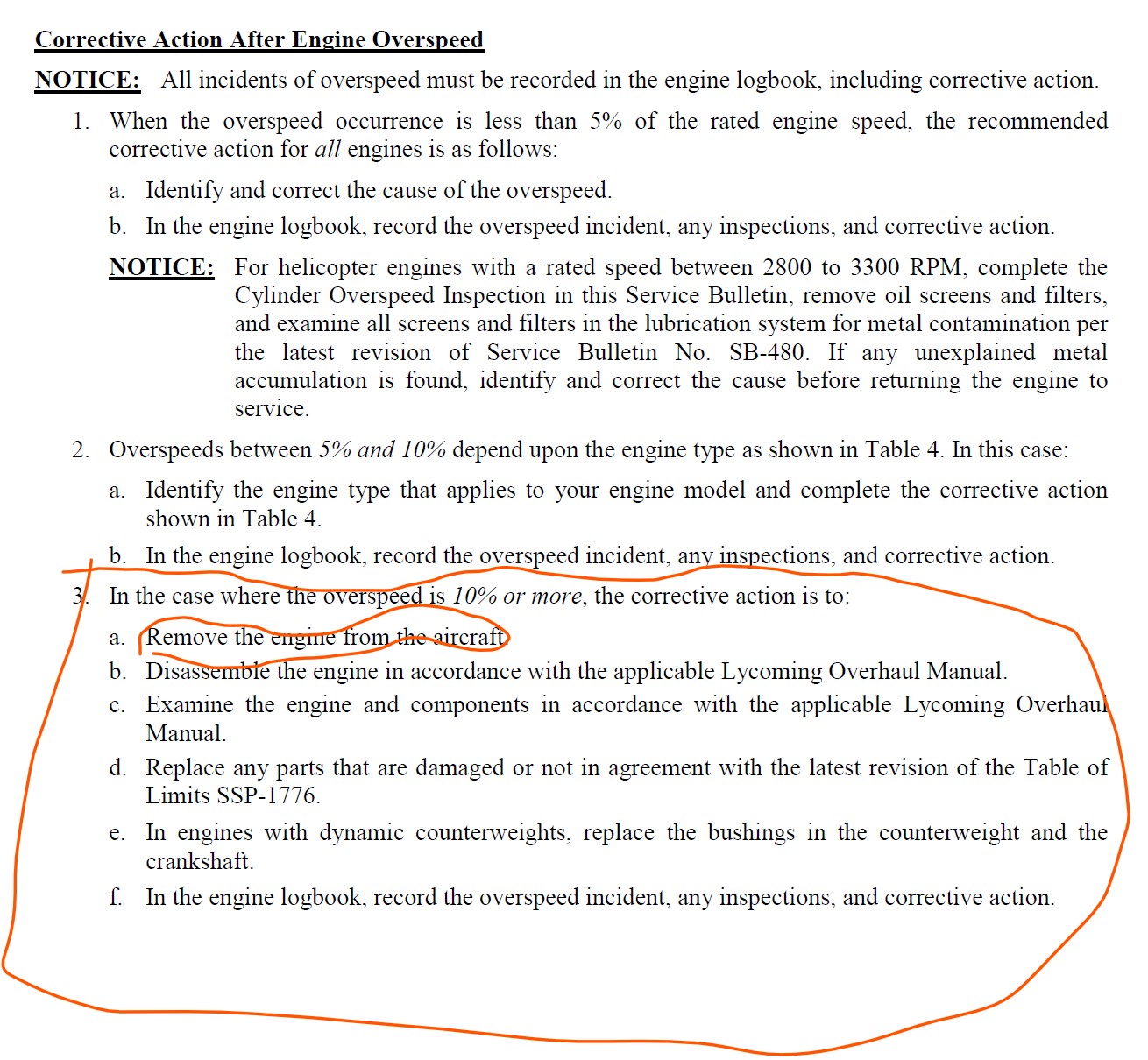
Hiller UH12E engine
- Lycoming VO 540 C2A

12E Engine
operating
Tips :
RPM and
MAP Control.
The big Lycoming
VO540C2A engine has plenty of grunt and is de-rated by MAP from 340
to 305 HP by not exceeding 26.0”MAP on a Std day at sea level.
Over-boosting
tends to cause trouble in the drive train and M/rotor hub. The
Bottom Planetary gears wear and the main rotor hub can crack
Over-revving
(exceeding 3200 Engine RPM) is another matter.
If you exceed 3520 rpm
you can
expect a con rod failure (usually Number 5 or 6 ) and sudden
engine stoppage between 150 and 250
hrs after the event.
Continuous
lesser over-revs will give the same result.
The engine has at
least 11 degrees of twist in the crankshaft at rest. This
straightens out at operating RPM and power! Use only smooth and slow
throttle movements when accelerating up or down in the green Tacho
Arc (3200 to 2900 RPM).
Read and
understand the complete latest version of Lycoming Service Bulletin
369 specifying the maintenance
requirements after exceeding 3200 RPM.



Don’t ignore the warnings!!
If you think you can fool the engine or hide your error -
read the link page "Metal has Memory" on the first page of
this website
For long engine life, operate at 3000 – 3100 ERPM, above transition.
The yellow arc
on the dual Tacho is a system resonance area in which the cooling
fan resonates and can develop cracks. Don’t get distracted and stay
in that range at any time while idling on the ground – pass smoothly
thru up or down.
Cold Start
(first start of the day) or cold day:
Start engine and
stay @1650/1700 RPM (no more) until the cylinder head temp passes
thru 50oC. The rattling noises are normal – don’t worry.
When thru
50oC – smoothly throttle up to idle at normal 22/2300.
ETIP2: all:
carb heat: If at any time in flight you feel that
“something is not right” with the engine – your first action, provided
that it is safe to do so (height, power requirements etc), would be to
pull the carb heat full on. This ensures that any potential carb ice
problems are eliminated.

Piston Helicopter Carburettor – Idle mixture adjustment
Many normal aspirated helicopter engines have
never
had the carb idle mixture adjusted since they were run in the test
stand at overhaul.
Here’s how to go about setting the idle mixture on the
Hiller UH12E twin carb set up.
This is about the hardest Helicopter to
adjust, so therefore most other machines can use the same basic system
for a single carb installation.
Safety
Notes:
This
procedure involves disassembly of the throttle controls and
therefore requires a duplicate inspection of the re-assembly
of these controls before further flight.
A
qualified pilot and aircraft maintenance engineer are required for
this procedure in Australia
A
briefing between the pilot and engineer must be carried out
before commencing this adjustment. Each must understand the sequence
of events and any emergency procedures
The
engineer must have adequate hearing protection due proximity
of the exhaust pipes
DO
NOT use this procedure in high wind conditions due low rotor RPM
(blade flapping)
Be
aware of the effects of local conditions AMSL.
At
all times, the manufacturer’s M/Overhaul manual and the Civil
Aviation Regulations have precedence over this advice and must
be complied with.
Work
Instructions(UH12E):
Read before commencment:
 |
Fly
one circuit to warm the whole helicopter to operating temperature
(reduces engine internal friction) |
 |
Land,
cool down and shut the engine off. |
 |
Throttle friction to full OFF |
 |
Using
appropriate tools, remove the split pin and then the nut and clevis
attaching the throttle cable to the carb throttle arm (note which
attach hole the clevis pin is in) |
 |
Restart the engine with the engineer ensuring that the Carb throttle
arm remains fully against the idle screw. |
 |
With
a screwdriver, wind out the throttle idle stop while maintaining
pressure on the throttle arm to close the carb butterfly valve.
Bring the engine revs down to 900 – 1000 RPM. (Yes, it will sound
rough and clunky) |
 |
Identify and slowly screw
in the large carb idle
mixture screw on the side of one carb until the engine runs rougher.
|
 |
Screw it out again until it seems smoother and then back in until
the engine starts running rough again. |
 |
Stop at this point and note
the position of the slot on the idle screw. |
 |
Then
screw the idle mixture screw out exactly two turns. |
 |
Do
this same procedure on the other carb. |
 |
Then
– DO IT AGAIN on BOTH Carbs. |
 |
The
idle mixture is now set. |
 |
Set
the idle speed at 1650 RPM (50% aprox) and shut down the engine with
the mixture control. |
 |
Reconnect and carry out a duplicate inspection of the throttle assy. |
 |
Restart the engine, check that full closed throttle on the
collective is actually caused by the idle stop screw on the carb and
not anywhere else in the control run. |
 |
Check
that the minimum engine idle speed is still 1650 ERPM, carb heat
cold. |
 |
Run
the engine to 3000 RPM and smoothly close the throttle to
check for correct needle split. DO NOT snap the
throttle shut as this is detrimental to the engine crankshaft assy. |
 |
Notate the aircraft logbook where appropriate. |
 |
Congratulations – you should now have an engine that is set for
better starting in your current ambient conditions. |



